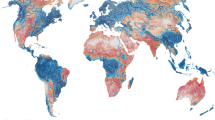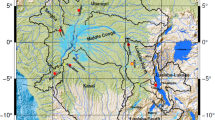Abstract
Reliable accounting of freshwater resources is key to managing hydrologic risk and balancing freshwater allocations for ecosystems and society. However, recent claims have argued that the global hydrometric network is not keeping pace with monitoring needs. Here we examine this question globally and reveal that over the past four decades the number of streamgaging stations reporting to global, open datasets has been declining. In the United States, a declining trend was reversed by the turn of the century, but high volatility at the river basin scale threatens continued monitoring in over a quarter of the river basins of the conterminous United States. We propose to prioritize streamgaging rescue by identifying watersheds that heavily rely on hydrologic data to support freshwater biodiversity conservation, and to manage flood or water scarcity risk to human populations. We argue that actions at different institutional levels are needed to secure the accumulation of long-term data needed for sustainable water management.
This is a preview of subscription content, access via your institution
Access options
Access Nature and 54 other Nature Portfolio journals
Get Nature+, our best-value online-access subscription
$29.99 / 30 days
cancel any time
Subscribe to this journal
Receive 12 digital issues and online access to articles
$119.00 per year
only $9.92 per issue
Buy this article
- Purchase on Springer Link
- Instant access to full article PDF
Prices may be subject to local taxes which are calculated during checkout




Similar content being viewed by others
References
Bell, B. The oldest records of the Nile floods. Geogr. J. 136, 569–573 (1970).
Guide to Hydrological Practices Volume I: Hydrology – From Measurement to Hydrological Information Report No. 168 (World Meteorological Organization, 2008).
Escriva-Bou, A., McCann, H., Hanak, E., Lund, J. & Gray, B. Accounting for California’s water. Calif. J. Polit. Policy 8, 1–26 (2016).
Natural Catastrophes (Munich RE, 2017); http://natcatservice.munichre.com
Advanced Hydrologic Prediction Service (AHPS) for Water Resources and Emergency Management (NOAA, 2017); http://www.nws.noaa.gov/ohd/ahps/ahps.htm
Vahedifard, F., AghaKouchak, A., Ragno, E., Shahrokhabadi, S. & Mallakpour, I. Lessons from the Oroville dam. Science 355, 1139–1140 (2017).
Milly, P. C. D. et al. Stationarity is dead: whither water management? Science 319, 573–574 (2008).
Willner, S. N., Levermann, A., Zhao, F. & Frieler, K. Adaptation required to preserve future high-end river flood risk at present levels. Sci. Adv. 4, eaao1914 (2018).
Hannah, D. M. et al. Large‐scale river flow archives: importance, current status and future needs. Hydrol. Process. 25, 1191–1200 (2011).
Vörösmarty, C. et al. Global water data: a newly endangered species. Eos 82, 54–58 (2001).
Granato, G. E. Computer Programs for Obtaining and Analyzing Daily Mean Streamflow Data from the U.S. Geological Survey National Water Information System Website (USGS, 2009).
Goodall, J. L., Horsburgh, J. S., Whiteaker, T. L., Maidment, D. R. & Zaslavsky, I. A first approach to web services for the National Water Information System. Environ. Model. Softw. 23, 404–411 (2008).
Fekete, B. M., Looser, U., Pietroniro, A. & Robarts, R. D. Rationale for monitoring discharge on the ground. J. Hydrometeorol. 13, 1977–1986 (2012).
Lanfear, K. J. & Hirsch, R. M. USGS Study reveals a decline in long‐record streamgages. Eos 80, 605–607 (1999).
Hirsch, R. M. & Costa, J. E. U.S. stream flow measurement and data dissemination improve. Eos 85, 197–203 (2004).
Nyabeze, W. R. Calibrating a distributed model to estimate runoff for ungauged catchments in Zimbabwe. Phys. Chem. Earth 30, 625–633 (2005).
Mishra, A. K. & Coulibaly, P. Developments in hydrometric network design: a review. Rev. Geophys. 47, RG2001 (2009).
US Geological Survey 2019 Budget Justification (USGS, 2018).
Poff, N. L. et al. River flows and water wars: emerging science for environmental decision making. Front. Ecol. Environ. 1, 298–306 (2003).
Ward, F. A. & Booker, J. F. Economic costs and benefits of instream flow protection for endangered species in an international basin. J. Am. Water Resour. Assoc. 39, 427–440 (2003).
Benson, R. D. Pollution without solution: flow impairment problems under Clean Water Act Section 303. Stanf. Environ. Law J. 24, 199–267 2005).
Van Putten, M. C. & Jackson, B. D. The dilution of the Clean Water Act. Univ. Mich. J. Law Reform. 19, 863–901 (1985).
Deweber, J. T. et al. Importance of understanding landscape biases in USGS gage locations: implications and solutions for managers. Fisheries 39, 155–163 (2014).
Anderson, D. R. The national flood insurance program. Problems and potential. J. Risk Insur. 41, 579–599 (1974).
Michel-Kerjan, E., Czajkowski, J. & Kunreuther, H. Could flood insurance be privatised in the United States? A primer. Geneva Pap. Risk Insur. Issues Pract. 40, 179–208 (2015).
Caldwell, A. W., Conrads, P. A., Mason, R. R. Jr & Berenbrock, C. USGS hurricane storm-surge monitoring networks: an example from Hurricane Rita. In Proc. 2010 South Carolina Water Resources Conference (2010); https://tigerprints.clemson.edu/cgi/viewcontent.cgi?article=1091&context=scwrc
Sankarasubramanian, A. et al. Synthesis of public water supply use in the US: spatio‐temporal patterns and socio‐economic controls. Earth’s Future 5, 771–788 (2017).
Alsdorf, D. E. & Lettenmaier, D. P. Tracking fresh water from space. Science 301, 1491–1494 (2003).
Hirsch, R. M. & De Cicco, L. A. User Guide to Exploration and Graphics for RivEr Trends (EGRET) and dataRetrieval: R packages for Hydrologic Data (USGS, 2015).
Devineni, N., Lall, U., Etienne, E., Shi, D. & Xi, C. America’s water risk: current demand and climate variability. Geophys. Res. Lett. 42, 2285–2293 (2015).
Maurer, E. P., Wood, A. W., Adam, J. C., Lettenmaier, D. P. & Nijssen, B. A long-term hydrologically based dataset of land surface fluxes and states for the conterminous United States. J. Clim. 15, 3237–3251 (2002).
Holmes, E. E., Ward, E. J. & Scheuerell, M. D. Analysis of Multivariate Time-Series Using the MARSS Package Version 3.9 (Northwest Fisheries Science Center, NOAA, 2014).
Ruhi, A., Olden, J. D. & Sabo, J. L. Declining streamflow induces collapse and replacement of native fishes in the American Southwest. Front. Ecol. Environ. 14, 465–472 (2016).
Evenson, E. J. et al. Strategic Directions for US Geological Survey Water Science, 2012–2022—Observing, Understanding, Predicting, and Delivering Water Science to the Nation (USGS, 2012).
Acknowledgements
We thank D. Yeskis, B. Reece and R. Mason (USGS) for answering our questions regarding US streamgage monitoring. We also thank M. Palmer and T. Grantham for their comments. A.R. was supported by the National Socio-Environmental Synthesis Center (SESYNC), under funding received from NSF DBI-1052875. Financial support was provided by a H. Mason Keeler Endowed Professorship (School of Aquatic and Fishery Sciences, University of Washington) to J.D.O.
Author information
Authors and Affiliations
Contributions
A.R., M.L.M. and J.D.O. designed the research. M.L.M. collated and visualized the data. A.R. and M.L.M. analysed the data. A.R., M.L.M. and J.D.O. wrote the paper.
Corresponding author
Ethics declarations
Competing interests
The authors declare no competing interests.
Additional information
Publisher’s note: Springer Nature remains neutral with regard to jurisdictional claims in published maps and institutional affiliations.
Supplementary information
Supplementary Information
Supplementary Figures 1 and 2; Supplementary Table 1, Supplementary references
Rights and permissions
About this article
Cite this article
Ruhi, A., Messager, M.L. & Olden, J.D. Tracking the pulse of the Earth’s fresh waters. Nat Sustain 1, 198–203 (2018). https://doi.org/10.1038/s41893-018-0047-7
Received:
Accepted:
Published:
Issue Date:
DOI: https://doi.org/10.1038/s41893-018-0047-7
This article is cited by
-
River-to-sea ecosystem management
Nature Sustainability (2023)
-
Identifying biases in the global placement of river gauges
Nature Sustainability (2022)
-
A bibliometric analysis and assessment of scientific studies trend on groundwater research in India during 1989–2020
Arabian Journal of Geosciences (2022)
-
Assessing placement bias of the global river gauge network
Nature Sustainability (2022)
-
Major shortfalls impairing knowledge and conservation of freshwater molluscs
Hydrobiologia (2021)



